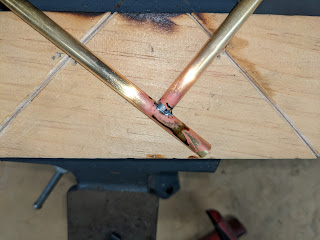First of all, IAS accuracy is brilliant when I went to a non-porous materials for the entire air path. I verified this by blowing into the probe and comparing a water manometer with the readings. The porous 3D printed material creates enough leakage to create enough of a flow to create enough of a head loss to change the results dramatically. The new probe nose is made out of HP "multi-jet fusion" plastic by http://jawstec.com/ and the prototype probe looks like this:
Note the tape because the temperature sensor bits were still in the mail. This is all getting improved.
I have moved to a brass brazed static probe that has a rectangular section to hold it in place securely, rather than the bent tubes that wiggled out of position. This is what it looks like, in progress and completed:
I have moved the probe protocol from TCP to UDP, to improve instant-on reliability. I have also made the Raspberry Pi display the Wi-Fi base station, to off-load complex work from the ESP32 probe. I completed the work on the Web configuration editor.
I updated the climb rate algorithm in the altimeter -- now it attempts to fit a polynomial to the latest N pressure altitude readings, and then reports the slope of that polynomial at the current time. It seems to be a better balance between stability and instant feedback. We'll see how it fares.
I added audio to Airball! I added a micro-framework for audio output, then added two sound "schemes". One is "FlyONSPEED" -- using the work of my friends at http://flyonspeed.org/. The other is "stallfence", which is just basically a simple progressive yaw and stall beeper. I hope to get more user feedback on what people want to see from audio!
I'm in a full-on production run of 5 units, followed by 10 more units. Wish me luck!





